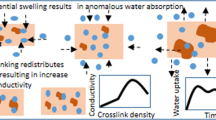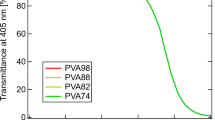Abstract
Asymmetric poly(vinyl alcohol) (PVA) membranes were prepared by the phase inversion technique, and crosslinked with glutaraldehyde. The degree of crosslinking of the membrane was controlled by varying the crosslinking conditions. The effects of the degree of crosslinking on the swelling characteristics, contact angles, critical surface tensions, and pervaporation characteristics were examined. A method for the evaluation of the degree of crosslinking, which needs only the gluaraldehyde concentration of the crosslinking solution to be measured after the crosslinking reaction, is proposed, and was found useful. The degree of swelling of PVA membrane for water decreases abruptly as the degree of crosslinking increases. However, the degree of swelling for ethanol is nearly independent of the degree of crosslinking. The critical surface tension of the membrane increases more or less within the range of 37.0–40.0 dyn cm−1 with increasing degree of crosslinking below 30%. But, it is nearly constant at 40.5 dyn cm−1 above 30%. The wetting behavior of the membrane may not be greatly affected by the degree of crosslinking. The selectivity factor and permeate flux of the membrane in the pervaporation of the ethanol-water mixture of 95 wt% ethanol concentration decrease similarly with increasing degree of crosslinking. The pervaporation characteristics seem to be closely related to the swelling behavior. The degree of crosslinking is an important variable for swelling behavior and pervaporation characteristics.
Similar content being viewed by others
Article PDF
References
W. Ying, Desalination, 46, 335 (1983)
H. E. A. Bruschke, G. F. Tusel, and R. Rautenbach, Am. Chem. Soc. Symp., 467 (1985).
N. A. Peppas and E. W. Merrill, J. Biomed. Mater. Res., 11, 423 (1977).
G. Sodeck, Proceeding of 1st International Conference on Pervaporation Process in the Chemical Industry, Atlanta, Georgia, February 23, 1986.
G. Smets and B. Petit, Makromol. Chem., 33, 41 (1959).
ASTM D2191-84, Philadelphia, Pa, U.S.A., 1987, p 448.
D. Teeters, J. F. Wilson, M. A. Andersen, and D. C. Thomas, Critical Sturface Tension, J. Colloid Interface Sci., 126(2), 641 (1988).
F. M. Fowkes, Ind. Eng. Chem., 56, 40 (1964).
D. W. V. Krevelen, “Properties of Polymers,” 2nd ed, Elsevier, Amsterdam, 1980.
A. W. Adamson, “Physical Chemistry of Surfaces,” 4th ed, John Wiley & Sons, New York, 1982.
B. R. Ray, J. R. Anderson, and J. J. Scholz, J. Phys. Chem., 62, 1220 (1958).
Y. S. Kang and H. C. Park, Polymer (Korea), 14(2), 178 (1990).
Y. Zhang, K. Zhang, and J. Xu, Mo Kexue Yu Jishu, 8(4), 8 (1988).
Author information
Authors and Affiliations
Rights and permissions
About this article
Cite this article
Kim, KJ., Lee, SB. & Han, N. Effects of the Degree of Crosslinking on Properties of Poly(vinyl alcohol) Membranes. Polym J 25, 1295–1302 (1993). https://doi.org/10.1295/polymj.25.1295
Issue Date:
DOI: https://doi.org/10.1295/polymj.25.1295
Keywords
This article is cited by
-
Fabrication of Radiopaque Poly(vinyl alcohol) Hydrogel Bilayers for Use as Embolization Coils
Macromolecular Research (2018)
-
Effect of aldehydes crosslinkers on properties of bacterial cellulose-poly(vinyl alcohol) (BC/PVA) nanocomposite hydrogels
Fibers and Polymers (2017)
-
Computational simulation of spirally coiled deformation of a Bi-Layered hydrogel strip induced by swelling
International Journal of Precision Engineering and Manufacturing (2015)
-
Preparation of PAM/PVA blending films by solution-cast technique and its characterization: a spectroscopic study
Iranian Polymer Journal (2014)
-
Effect of chemical crosslinking degree on mechanical properties of bacterial cellulose/poly(vinyl alcohol) composite membranes
Monatshefte für Chemie - Chemical Monthly (2014)



